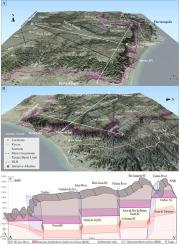Landscape evolution of the Torres Trough, Paraná Basin, southern Brazil, based on morphostructural analysis
IF 5.4
1区 农林科学
Q1 GEOSCIENCES, MULTIDISCIPLINARY
引用次数: 0
Abstract
The upper Paraná Basin units of the Serra Geral Group comprise the aeolian sandstones of the Botucatu Formation and overlying lava flows. Since distinct altitudes of the boundary between these units are observed (from 0 m up to 1200 m m.s.l), referred to as the Botucatu aeolian sandstones-lava flow boundary (BLB), it is as a key reference surface for identifying and quantifying major vertical faults and relative displacements across these faults. To map and model these displacements, integrated data from stratigraphic wells, fieldwork in key areas and remote sensing image analysis were utilized. Block displacements were observed in SSW-NNE profiles along the Southern escarpment, where the contact surface boundary ranges from sea level in the South to over 1200 m to the Northwest, indicating a progressively increasing elevation of the BLB towards the North. This trend is also evident in the ESE-WNW cross-section on the Serra Geral Plateau, where the BLB varies in stratigraphic well data from −534 m to 691 m from SW to NE. Additionally, the altitudes of the boundary between the Paraná Basin and the basement rocks (Basin-Basement Boundary − BBB) were analyzed, revealing the lowest points in a stratigraphic well in the NW (−3000 m) near the Torres Trough and the highest points in the NE (400 m). The significant altitude variations at both boundaries are constrained by the main lineaments observed in the area defining horst and graben domains. Notably, the Torres Trough, also referred to as the Torres Syncline, is identified as a structural low trending SE-NW. This suggests that the SE borders of the basin form part of the flanks of the Cretaceous rift, while the NE region represents a prominently uplifted block. The integration of lineaments delineates an extensive horst and graben system that developed post-Gondwana breakup, configuring four main domains based on the BLB altitudes: Torres, RS (−120 to 150 m), Timbé do Sul (200 to 500 m), Serra do Rio do Rastro (600 to 900 m), and Urubici, SC (1000–1300 m). Phanerozoic and later Cenozoic tectonic activity significantly altered the configuration of the Paraná Basin, through major block tilting and faulting, particularly along the escarpments.

基于形态结构分析的巴西南部巴拉那盆地托雷斯海槽地貌演变图
Serra Geral 组的巴拉那盆地上部单元包括博图卡图地层的风化砂岩和上覆的熔岩流。这些单元之间的边界海拔高度不同(从 0 米到 1200 米),被称为博图卡图风化砂岩-熔岩流边界(BLB),是确定和量化主要垂直断层以及这些断层之间相对位移的关键参考面。为了绘制和模拟这些位移,利用了来自地层井、关键区域实地考察和遥感图像分析的综合数据。在沿南部陡崖的 SSW-NNE 剖面上观察到了块体位移,接触面边界从南部的海平面到西北部的 1200 多米,表明基底层向北逐渐升高。这种趋势在 Serra Geral 高原的 ESE-WNW 横截面上也很明显,在地层井数据中,BLB 从西南到东北从-534 米到 691 米不等。此外,还分析了巴拉那盆地与基底岩石边界(盆地-基底边界-BBB)的海拔高度,发现地层井的最低点位于西北部(-3000 米),靠近托雷斯海槽,最高点位于东北部(400 米)。在这两个边界上的显著海拔高度变化受到了在该地区观察到的主要线状地形的制约,这些线状地形界定了地角域和地堑域。值得注意的是,托雷斯海槽(又称托雷斯斜坡)被确定为呈东南-西北走向的构造低地。这表明盆地的东南边界是白垩纪裂谷的侧翼,而东北地区则是一个突出的隆起区块。线状构造的整合勾勒出一个广泛的地角和地堑系统,该系统是在冈瓦纳断裂后形成的,并根据基底面海拔高度划分出四个主要区域:托雷斯山脉(-120 米至 150 米)、南廷贝山脉(200 米至 500 米)、里约拉斯特山脉(600 米至 900 米)和南卡罗来纳州乌鲁比奇山脉(1000 米至 1300 米)。新生代和新生代后期的构造活动极大地改变了巴拉那盆地的构造,主要表现为地块倾斜和断层,尤其是沿悬崖峭壁的地块。
本文章由计算机程序翻译,如有差异,请以英文原文为准。
求助全文
约1分钟内获得全文
求助全文
来源期刊

Catena
环境科学-地球科学综合
CiteScore
10.50
自引率
9.70%
发文量
816
审稿时长
54 days
期刊介绍:
Catena publishes papers describing original field and laboratory investigations and reviews on geoecology and landscape evolution with emphasis on interdisciplinary aspects of soil science, hydrology and geomorphology. It aims to disseminate new knowledge and foster better understanding of the physical environment, of evolutionary sequences that have resulted in past and current landscapes, and of the natural processes that are likely to determine the fate of our terrestrial environment.
Papers within any one of the above topics are welcome provided they are of sufficiently wide interest and relevance.
 求助内容:
求助内容: 应助结果提醒方式:
应助结果提醒方式:


